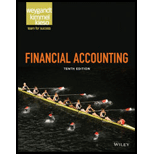
Concept explainers
(a)
Common Stock:
Common stock refers to a security signifying ownership in a corporation. Common stock comprises of equity capital of the company that is never paid back, and is lost if the company closes down. Voting share and ordinary shares are common terms associated with common stock. Common stock gives the right to stockholders to vote on corporate issues. They also come with pre-emptive rights, according to which the shareholder of a common stock is given the right to first refusal.
Dividends:
Dividends are the
Expenses:
Expenses are a kind of cost associated with the assets that may incur while performing a service or delivering a product, in order to generate revenues. It decreases the value of assets, as it is paid directly from it, thereby decreasing the stockholders' equity. There are different types of expenses like supply expense, rent expense, interest expense, and operating expense.
Revenues:
Revenue represents the total amount earned by a business from its sales and other sources, during a particular period of time. The total revenue of a firm can be determined as the selling price of the good or service of the company times the number of quantities sold.
The amount invested to a business by its shareholder or the donated capital and earnings from operations less any dividends issued gives the stockholders’ equity. The stockholders’ equity gives the ownership claim on the total assets of a business. The amount left after satisfying the creditors, belongs to the stockholders’ claim on the assets. It also includes common stock and retained earnings.
Whether cash received for services performed is a common stock (C), dividends (D), revenue (R), expense (E), or not affecting stockholders' equity (NSE).
(b)
Whethercash paid to purchase equipment is a common stock (C), dividends (D), revenue (R), expense (E), or not affecting stockholders' equity (NSE).
(c)
Whetherpayment made to employees is a common stock (C), dividends (D), revenue (R), expense (E), or not affecting stockholders' equity (NSE).
Want to see the full answer?
Check out a sample textbook solution
Chapter 1 Solutions
Financial Accounting
- Accounting discuss, please expand upon and add some extra infoarrow_forwardPlease provide the solution to this financial accounting question using proper accounting principles.arrow_forwardI need help finding the accurate solution to this financial accounting problem with valid methods.arrow_forward
- Can you explain this financial accounting question using accurate calculation methods?arrow_forwardI am looking for help with this financial accounting question using proper accounting standards.arrow_forwardPlease provide the correct answer to this financial accounting problem using accurate calculations.arrow_forward

 AccountingAccountingISBN:9781337272094Author:WARREN, Carl S., Reeve, James M., Duchac, Jonathan E.Publisher:Cengage Learning,
AccountingAccountingISBN:9781337272094Author:WARREN, Carl S., Reeve, James M., Duchac, Jonathan E.Publisher:Cengage Learning, Accounting Information SystemsAccountingISBN:9781337619202Author:Hall, James A.Publisher:Cengage Learning,
Accounting Information SystemsAccountingISBN:9781337619202Author:Hall, James A.Publisher:Cengage Learning, Horngren's Cost Accounting: A Managerial Emphasis...AccountingISBN:9780134475585Author:Srikant M. Datar, Madhav V. RajanPublisher:PEARSON
Horngren's Cost Accounting: A Managerial Emphasis...AccountingISBN:9780134475585Author:Srikant M. Datar, Madhav V. RajanPublisher:PEARSON Intermediate AccountingAccountingISBN:9781259722660Author:J. David Spiceland, Mark W. Nelson, Wayne M ThomasPublisher:McGraw-Hill Education
Intermediate AccountingAccountingISBN:9781259722660Author:J. David Spiceland, Mark W. Nelson, Wayne M ThomasPublisher:McGraw-Hill Education Financial and Managerial AccountingAccountingISBN:9781259726705Author:John J Wild, Ken W. Shaw, Barbara Chiappetta Fundamental Accounting PrinciplesPublisher:McGraw-Hill Education
Financial and Managerial AccountingAccountingISBN:9781259726705Author:John J Wild, Ken W. Shaw, Barbara Chiappetta Fundamental Accounting PrinciplesPublisher:McGraw-Hill Education





